Newgate Gaol, City of London, London
Henry II's Assize of Clarendon, a series of Acts issued in 1166, gave the Crown more control over the administration of justice. It introduced a jury system to examine each case at assize courts, which were to held periodically in each of England's county towns, and ruled over by visiting circuit judges. It was also decreed that each town should have a county gaol where those awaiting trial should be confined until the next assize took place. The first of these prisons to be established was Newgate, serving the county of Middlesex.
The prison was housed in London's Newgate entrance, so called because it was erected in the reign of Henry I, several hundred years after the four original gates gates of the city.
In 1236, the prison was enlarged by taking over one of the Newgate's turrets, and some adjacent buildings. In 1406, a separate tower and chamber were added for the use of female prisoners. Over the next century, the building became increasingly overcrowded and insanitary, with 'gaol fever' and other diseases causing death among the inmates. Eventually, in 1419, it was decided to close the prison until the problems could be remedied.
In 1423, money from the estate of the recently deceased former Lord Mayor, Richard ('Dick') Whittington, was used to rebuild the gate and the prison. New facilities included a central dining hall, and enlarged accommodation for up to 300 inmates. The prison then comprised three sections: the Master's Side, for those could afford to pay for their own food and accommodation; the much more basic Common Side, for poor inmates; and the Press Yard for special prisoners such as traitors and heretics from outside the county, who were brought to London for trial. The prison housed both felons and debtors, with males and females in separate wards.
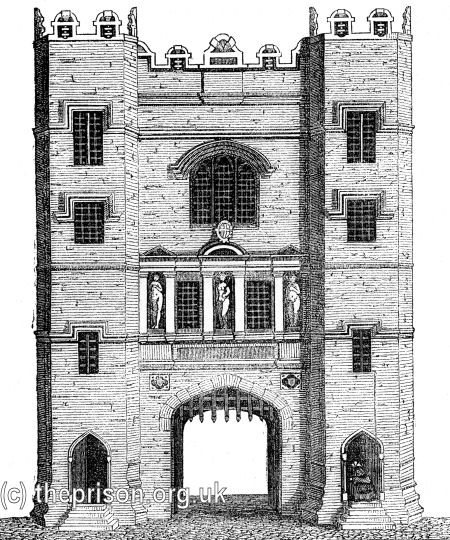
Newgate Prison, London. © Peter Higginbotham
In 1666, the prison was seriously damaged in the Great Fire of London, but was rebuilt in 1672 by Sir Christopher Wren, extending it onto the south side of Newgate Street.
The prison site is shown on the 1746 map below.
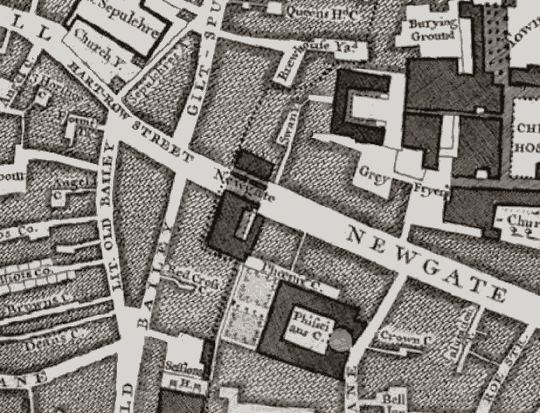
Newgate Gaol site, London, 1746.
In 1777, John Howard described the cells used to hold condemned malefactors:
There are upon each of the three floors five cells: all vaulted, near nine feet high to the crown. The cells on the ground-floor measure full nine feet by near six; the five on the first story are a little larger, on account of the set-off in the wall, and the five uppermost, still a little larger for the same reason. In the upper part of each cell, is a window double grated, near three feet by one and a half. The doors are four inches thick. The strong stone wall is lined all round each cell with planks, studded with broad-headed nails. In each cell is a barrack-bedstead. I was told by those who attended me, that criminals who had affected an air of boldness during their trial, and appeared quite unconcerned at the pronouncing sentence upon them, were struck with horror, and shed tears when brought to these darksome solitary abodes.
Newgate was particularly noted for it use of the press, or peine forte et dure, which was applied to prisoners who refused to make a plea, without which a trial could not proceed. In its Press Yard, the accused was stripped and placed on the ground under a board with rocks piled on top until they either died or agreed to plead. For someone clearly determined not to plead, death could be hastened by placing a sharp stone under their back. Pressing was abolished in 1772 and prisoners refusing to plead were then treated as guilty. The illustration below shows highway robber William Spiggott undergoing the press at Newgate in 1721. Spiggott withstood a weight of 350lb for half an hour but finally agreed to plead after a further 50lb was added. In due course he was convicted and hanged.
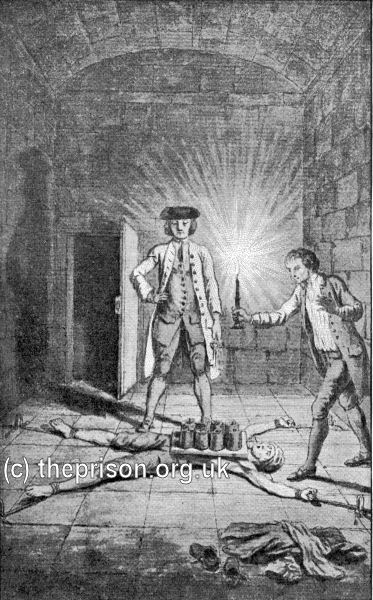
The Press at Newgate Prison,London, 1751. © Peter Higginbotham
Ventilation in the prison was a frequent problem. By 1750, the gate had a large rooftop 'sail ventilator' to assist the circulation of air around the building.
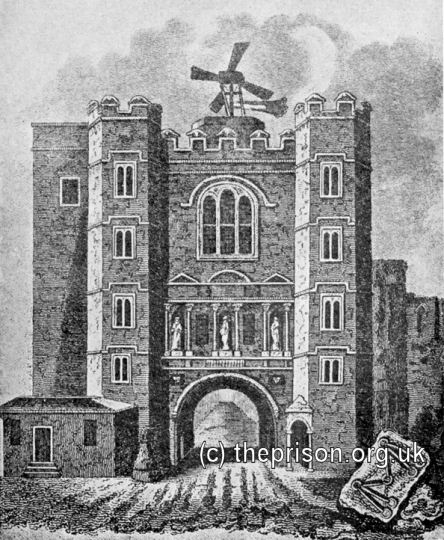
Newgate Prison, London, c.1750. © Peter Higginbotham
A further enlargement of the prison began in 1770, together with construction of a new sessions house. Around 900 square yards (750 square metres) of additional land for the scheme was provided by the City of London, while parliament contributed a grant of £50,000. The architect for the development was George Dance, whose design presented a deliberately severe external appearance, intended to discourage law-breaking. During the Gordon Riots, in June 1780, when construction work was almost completed, the building was stormed by a mob and set on fire. The cost of the damage was around £30,000. The building was eventually completed in 1782.
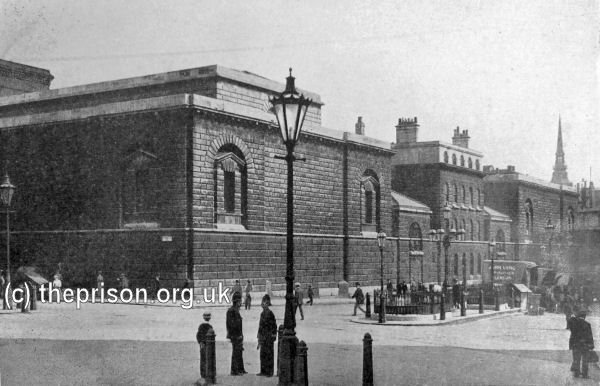
Newgate Prison, London, c.1900. © Peter Higginbotham
The prison was now divided into three sections: one for male felons, one for female felons, and one for debtors, as shown on the plan below, published in 1800.
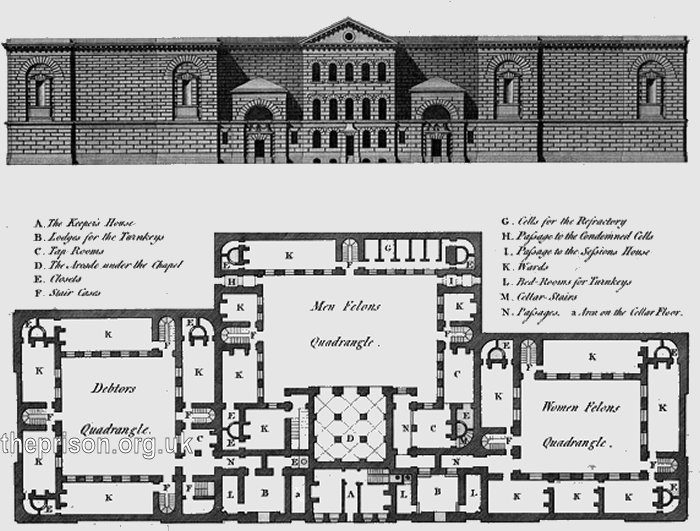
Newgate Gaol ground plan, London, 1800.
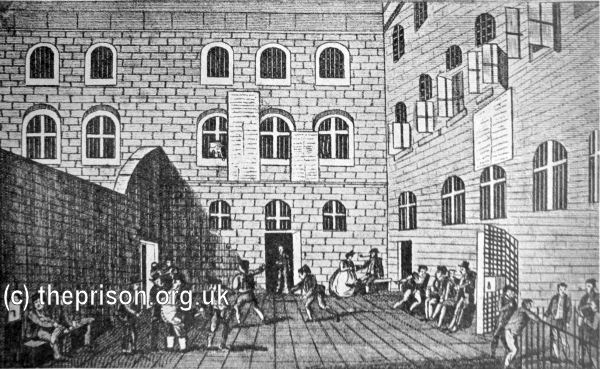
Debtors' Yard at Newgate Prison, London, c.1809. © Peter Higginbotham
In 1812, James Neild wrote:
The Prisoners in this strong-hold are divided into two general classes; viz. Debtors, and Criminals; and those of the latter description into four other classes:
I. Capital Convicts, under Sentence of Death.
II. Transports, and Respited Convicts.
III. Persons under Sentence of Imprisonment, for certain determinate periods of time; or until they shall have paid certain Fines or Amercements: And
IV. Prisoners detained for Trial; not so much distinguishing between the magnitude of the particular Crimes wherewith they stand charged, or of which they may be convicted, as between the Habits of Life of the individuals; many of whom are well known in Courts of Justice; and who, although at times they may be committed for crimes apparently or comparatively small, are yet of manners more likely to corrupt the morals of young offenders, than some of those Convicts who are under Sentence of Transportation, or Fine, or Imprisonment. The Males, too, of all the above criminal classes are kept separate from the Females of their class; and so, likewise, are the Capital Convicts from other Criminals.
This Gaol of Newgate is accordingly divided into eight separate and distinct court-yards; of which, two on the North-West angle are appropriated for Debtors, viz.
No. 1. The Men Debtors' court, leading to three Wards, called "The Cabin-Side;" each Ward being 37 feet long by 14½ wide, and having four cabins or small rooms in each, of about 7 feet and a half square, and capable of containing twenty-four persons within the three Wards, reckoning two to each cabin: also leading to two other Wards, called the Masters Side, being each 23 feet long by 14½ wide, capable of containing about twenty persons; and to a day-room of the same dimensions, fitted up with benches and settles, after the manner of a tap-room in a public house; and also leading to eight other wards, called the Common-Side, one of which is 36 feet; six others, about 23 feet; and the one other 18 feet in length; all of these are about 15 feet wide, and together capable of containing about 90 persons.
No. 2. The Women-Debtors' court-yard, about 49 feet long by 16 feet wide, leads to two Wards; one of which is 36 feet long by 15 feet wide, and the other 18 feet long by 15, wide; and these are calculated to contain about 22 persons.
All the before-mentioned Wards are about 1 1 feet high. These yards are separated from each other by a stone wall 15 feet high, and both well supplied with water. The Debtors, who are enabled, all find their own beds and bedding; but the poor, as well Debtors as Criminals, are sometimes supplied with rugs by the City.
No. 3. The Capital Convicts' court-yard; which is also called the "Press-Yard," on account of a press having been, of old time, kept there, for the punishment of persons who stood mute through obstinacy, and refused to plead to the indictments found against them. The manner was this: the culprit being laid upon his back, a board was placed over him, on which was put a succession of heavy weights, until he either pleaded Guilty or Not Guilty to the indictment, or died through the extremity of pressure. This barbarous custom, however, has been justly abolished for nearly a century; nor is it now customary (as heretofore) for the Executioner to put a whip-cord round the thumbs of condemned Prisoners, when brought up to receive Judgment of Death; nor for the Bellman of St. Sepulchres parish to go into the passage leading to the cells, to pronounce two exhortations to such condemned persons on the solemn night before their execution; their time, it is hoped, being much better employed in prayer, and preparation for so awful an event, assisted by some pious Christians, who frequently come from various parts of the Metropolis, and pray with them the whole of that night, and until the Ordinary arrives in the morning, to attend them in their last moments, having administered to them the Sacrament the day before.
This court-yard is about 85 feet long, by 20 wide at one end, and about 15, at the other end, leading to the Condemned Room, This is a day-room for the Capital Convicts, and is about 35 feet by 18; behind which is the cold bath, and over it the Men's Infirmary, of the same dimensions, having five sash windows, and a fire-place. It is furnished with eleven iron bedsteads, sacking bottoms, flock bed and bolster, three blankets, two sheets, and a rug to each.
The Press-Yard also leads to the Condemned Cells, fifteen in number; which are all vaulted, and nearly 9 feet high, to the crown of the arch. In the upper part of each of these condemned cells is a window, double grated, of 2 feet 9 inches wide, by 14 inches high. The doors are 4 inches thick; through each of which a circular aperture, of 23/8 inches diameter, was made by Mr. Kirby, the late worthy Keeper of this Gaol, for the purpose of admitting a free current of air; and in each cell is a barrack bedstead on the floor, without bedding.
The strong stone-wall is lined all round each cell with planks, studded with broad-headed nails.
No. 4. The Chapel-Yard is about 43 feet long by 25; in which, as nearly as may be, are confined the Men Transports, and oldest offenders. It leads to five wards, of 20 feet by 15 each, and to one other ward of 15 feet square; all of them fitted up with barrack bedsteads on the floor, without bedding, and capable of containing about 60 Prisoners. This yard, also, as its name indicates, leads on to the body of the Chapel; on the stair-case to which are two rooms, each 15 feet square, and used for the confinement of those accomplices in crimes, who are usually termed "Kings Evidence," and admitted to give testimony on the part of the Prosecution. Here, therefore, they are kept retired, and separate from the reach of the other joint offenders, who might otherwise be inclined to ill treat, or perhaps to murder them.
There are two other stair-cases to the galleries of the Chapel; one leading from a lodge on the Debtors' Side, the other from a lodge on the Felon Side of the Gaol.
No. 5. The Middle Yard, about 50 feet by 25, in which the less profligate are confined, leads on to five wards, each 38 feet long by 15; fitted up with barrack bedsteads on the floor, without bedding, and capable of containing about 120 persons. In this middle yard there is also an arcade under the Chapel, in which are three cells, for the temporary confinement of very refractory Prisoners.
No. 6. The Men Felons' Master-Side yard, which also is about 50 feet by 25, and contains the more decent and better-behaved Prisoners, leads on to a room, in which are lodged those Prisoners called "Gatesmen;" whose business it is to direct the friends of the others in this Gaol to the different wards in which they are confined. It leads, likewise, to seven wards; one 3S feet long, four of about 20 feet, the other two of about 15 feet, and all of them nearly 15 feet wide. These are capable of containing about 90 persons; and are supplied with barrack-beds, and bedding on the floor, furnished by the Gaoler, at 2s. 6d. per week each.
No. 7. The Women Felons' two court-yards, laid into one, adjoin each other at right angles; the one 40 feet, the other 20 feet long; and both about 10 feet wide. These lead to nine wards, three of which are about 30 feet by 15; the other six about 15 feet by 10; and all fitted up with barrack-bedsteads laid on the floor, except one large ward on the attick story, which is set apart for the Female Infirmary. This capacious apartment has four casement windows, and two fire-places; and, like all the other wards, is about 11 feet high. It is furnished with ten iron bedsteads, sacking bottoms, flock bed, bolster, &c. to each, exactly the same as in the Men Felons' Infirmary, already described under No. 3. The other eight wards can accommodate about 90 persons; and in this range all sorts of Female Criminals are confined, there being no other suitable means of keeping them distinct in their respective classes.
The Women's wards are generally, indeed, so crowded, as not to admit a space of twenty inches for each to sleep, on the bare boards, and without any bedding whatever!
No. 8th, and last, is the court-yard called the State-Side, about 40 feet long by 30; where such Prisoners are safely associated, whose manners and conduct evince a more liberal style of education, and who therefore are lodged apart from all other districts of the Gaol. This yard leads to twelve rooms; three of them about 21 feet by 15, the next three about 18 feet by 15; three others nearly 1 5 square, and the rest about 1 1 feet square. These rooms are calculated to receive 30 persons, and furnished by the Keeper with bedsteads, bedding, &c. at seven shillings each per week.
All the several floors throughout this ample Prison have sewers, or water-closets, properly disposed. The eight courts above enumerated are well supplied with water; and dust-bins of stone are suitably distributed, to receive all the ashes and other dirt, which are taken away every week by the City Scavenger.
The two lodges, or first entrances to the Debtors' and Felons' Sides of Newgate, have each a small room adjoining, where one or more of the Turnkeys, like the eyes of Argus, keep watch and ward day and night. They have, likewise, staircases leading to the Chapel Galleries, like those before noticed; and also to two rooms, with two cells in each, which are set apart either for the temporary confinement of refractory Debtors, or for Female Convicts unhappily ordered for execution; no Woman Convict being ever, otherwise, confined in a cell. The same staircases lead also to the apartments of the servants belonging to the Prison.
On the Debtors' Side, and beyond the lodge, is a convenient room for the Turnkeys; and near it a grating, through which the Debtors receive their beer from the neighbouring publick houses. The Felons' Side has a similar accommodation; and this mode of introducing their beverage is adopted, because no publican, as such, can be permitted to enter the interior of this Prison.
There is, likewise, a convenient room beyond the Felons' Side lodge, to accommodate the servants of the Gaol. This, formerly, (when the Keeper had permission to sell beer,) was the tap-room; and, near to it is another apartment, heretofore called the "Wine Room" with a copper, &c. fixed up, in order to cook the provisions humanely sent in by the Lord Mayor, the Sheriffs, and other friends. Into this apartment persons accused of Felony are now occasionally admitted; either to consult with their legal advisers, or to see such of their relatives or acquaintance, as may not be allowed to visit them in their own wards.
On the top of the Gaol are a watch-house, and a sentry-box; where two or more guards, with dogs and fire-arms, in addition to the Turnkeys below, watch all night.
Adjoining to the Felons' Side lodge is also the Keeper's office, where the Prison Books are kept; and his Clerk, called the Clerk of the Papers, attends daily, (Sundays excepted,) from ten in the morning till two in the afternoon, and from four till eight in the evening.
Here are also communications, from the Men Felons' Master Side Yard, and from that of the Female Felons, with the Sessions-House in the Old Bailey, by means of an arched passage, through which the Prisoners are led into Court to take their Trials
This Prison, though comparatively vast, is generally crowded. Newgate will conveniently accommodate ninety-four Men, and sixteen Women Debtors; also three hundred Men, and eighty Women Criminals; making a total of 490 persons. It might be rendered capable of containing about 750 persons in the whole, allowing a space of 7 feet 6 inches by 3 feet for every Criminal, and rather more for every Debtor, according to the size and shape of the room. The greatest number of Debtors ever confined here at one time, has been 285 Men, and 40 Women: and, astonishing as it may appear, I have been informed that there have been in it nearly nine hundred Criminals at the same time; making, in all, upwards of twelve hundred Prisoners!
From 1783 until 1902, the execution of condemned prisoners too place at Newgate, having previously been held at Tyburn. Over that period, a total of 1,169 people suffered this fate — 1,120 men and 49 women. From 1809, hangings took place on a portable gallows placed in front of the Debtors' Door on Old Bailey.
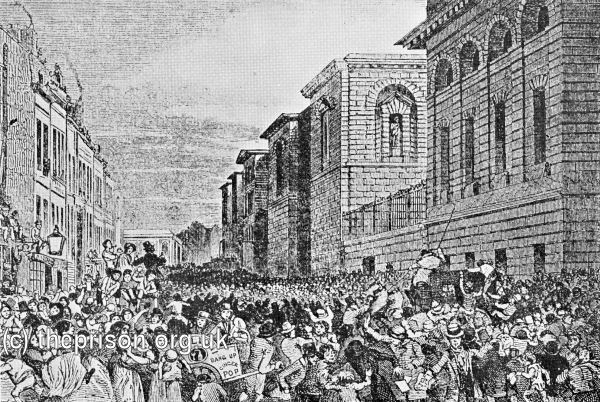
Crowds at a public execution outside Newgate Prison, London. © Peter Higginbotham
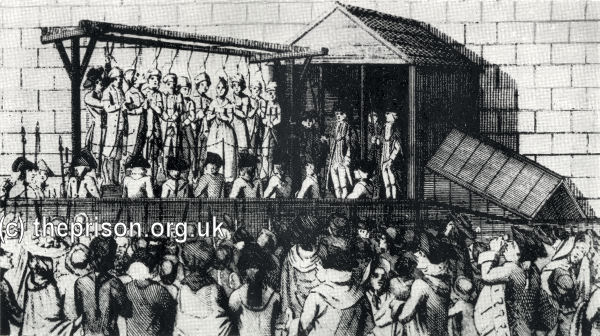
'The Drop' outside Newgate Prison, London. © Peter Higginbotham
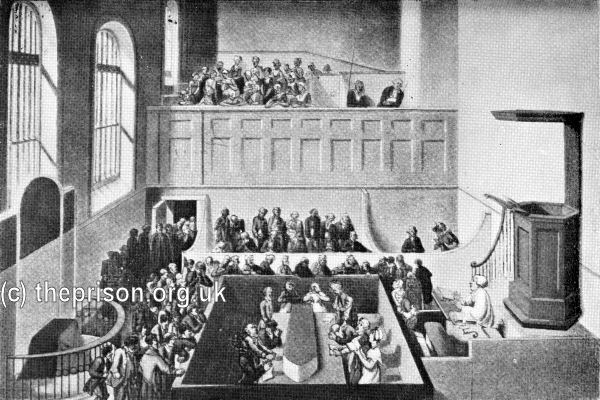
Chapel with condemned criminals and coffin at Centre, Newgate Prison, London, 1809. © Peter Higginbotham
From 1868, the executions took place inside the prison.
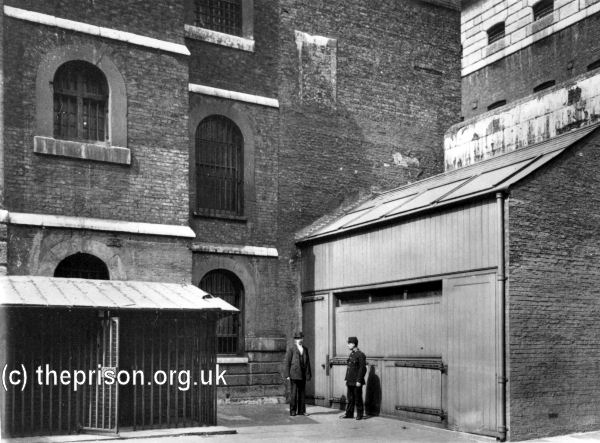
Execution shed at Newgate Prison, London. © Peter Higginbotham
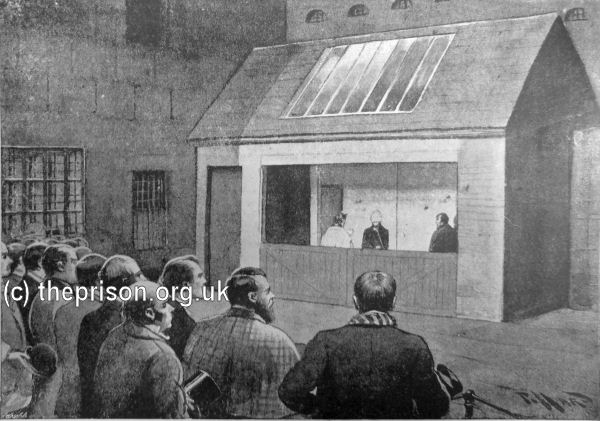
Execution shed at Newgate Prison, London. © Peter Higginbotham
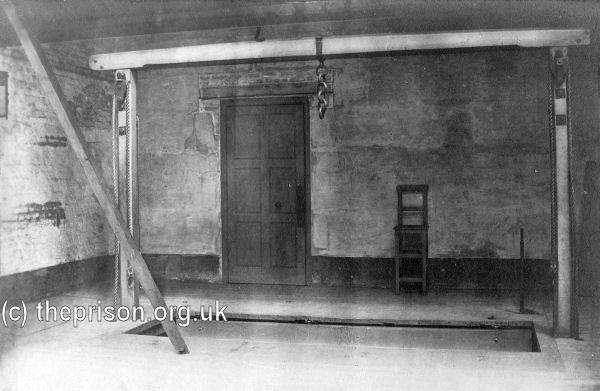
Execution shed at Newgate Prison, London. © Peter Higginbotham
During the early 19th century, the Quaker social reformer Elizabeth Fry visited Newgate, where she found 'riot, licentiousness and filth'. She was particularly concerned at the conditions in which female prisoners were held and campaigned for better conditions such as their segregation from male inmates and the provision of uniforms, educational and religious classes, and paid work to allow them to save money for when they were released. Some of her reforms, such as the banning of alcohol and playing cards, proved less than popular with the inmates, however.
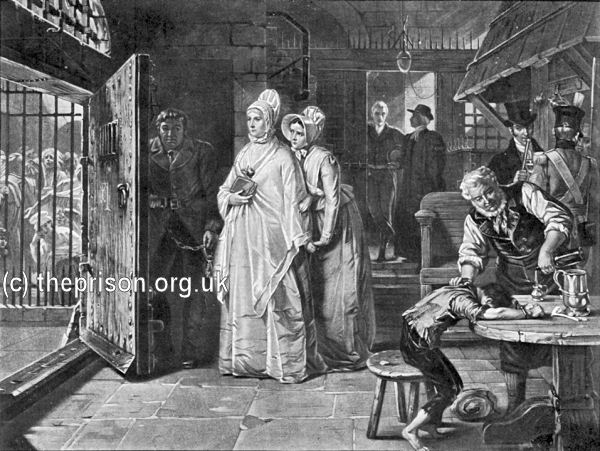
Elizabeth Fry at Newgate Gaol, London, 1820s. © Peter Higginbotham
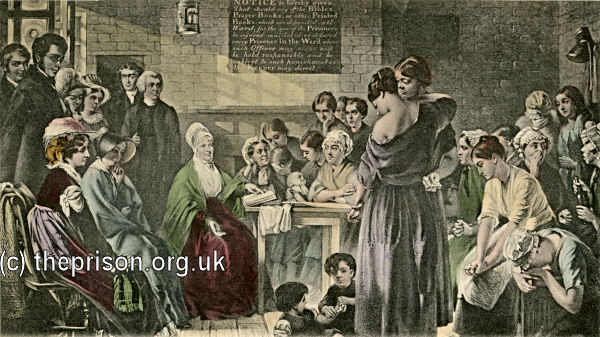
Elizabeth Fry at Newgate Gaol, London, 1820s. © Peter Higginbotham
The layout of the prison in the 1850s is shown below, by which date some partitioning of the wards and yards had taken place:
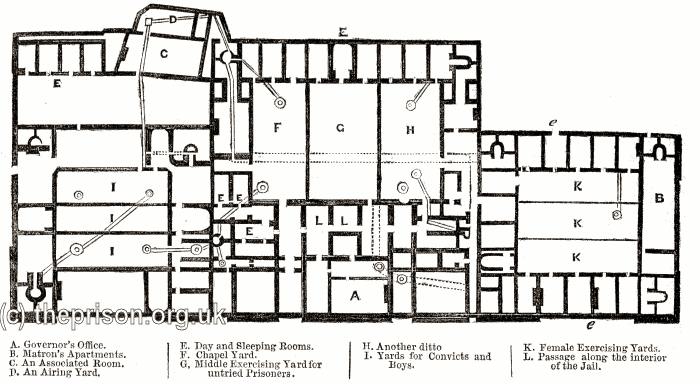
Newgate Gaol ground plan, London, 1850s.
In 1858, the prison interior was remodelled and extended to provide the inmates with individual cells. Its subsequent layout is shown in the plan below:
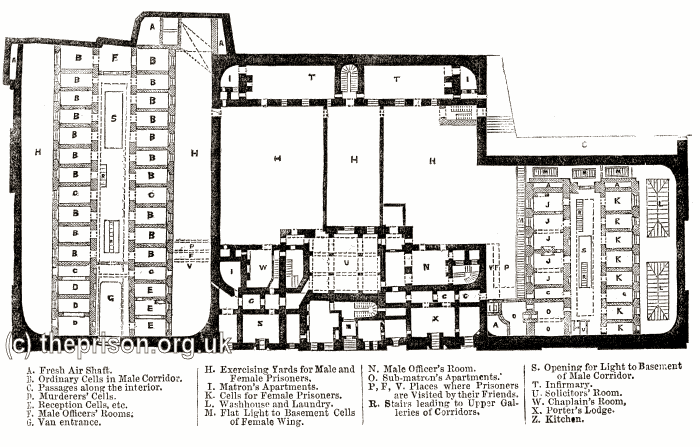
Newgate Gaol ground plan, London, 1860s.
The prison closed in 1902, and was demolished in 1904. The new Central Criminal Court, known as the Old Bailey, was then erected on the site.
Records
Note: many repositories impose a closure period of up to 100 years for records identifying individuals. Before travelling a long distance, always check that the records you want to consult will be available.
- London Metropolitan Archives, 40 Northampton Road, London EC1R OHB. Extensive holdings include: Minutes and papers of the Committee to enquire into the state of Newgate Gaol and its enlargement (1755-66); Minutes, papers and journals of the Committee for rebuilding Newgate (1767-1831); Visiting Justices minutes (1814-77, with gaps); Returns as to state of prison and prisoners' health (1812-19); Regulations (1860); Plans (c.1750-1902); Calendars or lists of prisoners (1796-7, 1819, 1828); Calendars of Middlesex prisoners after trial (1711-74, with gaps); Printed calendars of prisoners (1820-22, 1830-53); Inquests into deaths of prisoners (1783-1839, with gaps). Also holds the records of the Sessions of Gaol Delivery of Newgate for the City of London and Middlesex held at the Old Bailey until 1834 when they were replaced by the Central Criminal Court whose records are held by The National Archives. Also holds calendars of indictments. Other calendars of prisoners held at Newgate can be found on the sessions rolls and amongst the sessions papers for the City of London and Middlesex.
- The National Archives, Kew, Richmond, Surrey, TW9 4DU. Has a wide variety of crime and prison records going back to the 1770s, including calendars of prisoners, prison registers and criminal registers.
- Find My Past has digitized many of the National Archives' prison records, including prisoner-of-war records, plus a variety of local records including Manchester, York and Plymouth. More information.
- Prison-related records on
Ancestry UK
include Prison Commission Records, 1770-1951
, and local records from London, Swansea, Gloucesterhire and West Yorkshire. More information.
- The Genealogist also has a number of National Archives' prison records. More information.
Census
Bibliography
- Higginbotham, Peter The Prison Cookbook: A History of the English Prison and its Food (2010, The History Press)
- Brodie, A. Behind Bars - The Hidden Architecture of England's Prisons (2000, English Heritage)
- Brodie, A., Croom, J. & Davies, J.O. English Prisons: An Architectural History (2002, English Heritage)
- Harding, C., Hines, B., Ireland, R., Rawlings, P. Imprisonment in England and Wales (1985, Croom Helm)
- McConville, Sean A History of English Prison Administration: Volume I 1750-1877 (1981, Routledge & Kegan Paul)
- Morris, N. and Rothman, D.G. (eds.) The Oxfod History of the Prison (1997, OUP)
- Pugh R.B. Imprisonment in Medieval England (1968, CUP)
Links
- Old Bailey online — Printed journalistic accounts of trials of prisoners from Newgate.
- London Lives website has surviving sessions papers for the City of London, Middlesex and Old Bailey Sessions (1690-1799) including calendars of prisoners for Newgate.
- Prison Oracle - resources those involved in present-day UK prisons.
- GOV.UK - UK Government's information on sentencing, probation and support for families.
Except where indicated, this page () © Peter Higginbotham. Contents may not be reproduced without permission.



